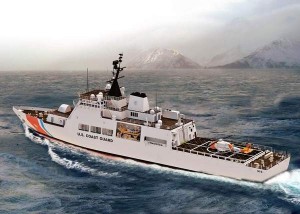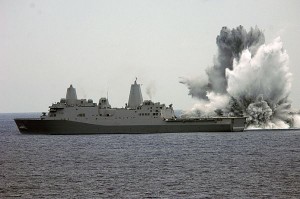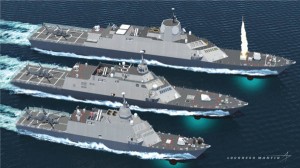 The American habit of cramming the functions of four to five legacy ship classes into a single, bespoke multifunction hull is–for now–over.
The American habit of cramming the functions of four to five legacy ship classes into a single, bespoke multifunction hull is–for now–over.
With the U.S. fleet operating only a handful of core classes, and looking at one-for-one replacements of existing platforms (at best), the U.S. Navy is now free to get back to focusing on mission basics in follow-on/replacement hulls.
And that’s good.
You can’t go wrong by focusing on the basics. It’s something the U.S. Coast Guard is learning with the Offshore Patrol Cutter (yes, I know the wags out there will be quick to remind me that the OPC is replacing three different “Classes” of Medium-sized Cutters), but the missions for those three legacy platforms are one and the same (with some minor differences in capability, geographical suitability, etc.).
In OPC development, the U.S. Coast Guard has been undistracted, unabashedly focused on OPC seaworthiness and in supporting a few key attributes that really help the Coast Guard carry out their key statutory missions.
And they’re going to get a winner.
LPD-17: Many Missions, Master of None:
 Compare the OPC with the Pentagon’s long-standing effort to sell the 12-hull LPD-17 Program…a Program originally portrayed as a replacement for 4 types of amphibious vessels (41 ships).
Compare the OPC with the Pentagon’s long-standing effort to sell the 12-hull LPD-17 Program…a Program originally portrayed as a replacement for 4 types of amphibious vessels (41 ships).
The idea that the LPD-17 could adequately “replace” such a sprawling array of mature amphibious assault designs was, at best, an overheated dream of warrior accountants and some overly-pliant operational analysis guys.
Heck, the LST 1179 Class was a specialized landing craft, meant to be beached (Call me when an LPD-17 skipper survives the first LPD-17 beaching/grounding). The AKA-113 class was a specialized transport and amphibious support craft, and the LPD 4/LSD 36 were earlier-generation amphibs (Personally, I object to LPD-17 replacing the LSD-36 class because…the true LSD-36 follow-ons, the Whidbey Island/Harpers Ferry Classes, didn’t just spring out of thin air).
At any rate, the lack of focus let the LPD-17 Program sprawl into a do-anything, multi-billion dollar platform. Because LPD-17 replaced so many ships, the LPD-17 became valuable. Because LPD-17 was valuable, it needed protection. And because the ship needed protection…
“…the LPD-17 will be a bonafide warship. It will bring to the theatre the new Cooperative Engagement Capability which will enable it to share target tracks with Aegis ships: the Vertical Launch System for land attack missions and the Rolling Airframe Missile for ship self defense…the combat capability planned for the LPD -17 will allow it to defend itself and participate in land attack missions, freeing up Aegis ships, when necessary, for other missions…”
You get the idea. (That was USMC Lt. General Edward Hanlon Jr. in a 1997 issue of Naval Forces: International Forum For Maritime Power.)
On the face of it, claims that a 12-hull ship class could replace 41 ships was, at best, artful.
And as the LPD-17 program shrank–in both capability (remember the unused VLS cells on LPD-17 that the Marines turned into a climbing wall?) and number (remember when the LPD-17 shrank to 9 hulls?) the Program lost all credibility by clinging to the old statement–that the LPD-17 Program “functionally” replaced 41 ships.
Now….let’s rewind history and imagine if the LPD-17 was sold as a simple, one-for-one replacement for the 12 LPD-4 ships. (Which is, ironically enough, what the LPD-17 really is–when the program ends, we will see that twelve LPD-17s replaced twelve LPD-4s, full stop.)
Yes, wags will scoff that the LPD-17, as a one-for-one replacement for the LPD-4s, would have never been “sold” on the Hill–which may have been true at the time–but surely a more limited focus would have kept the LPD-17 from becoming the fragile, multi-billion-dollar aspirational dream-combatant that “everybody on the committee” wanted.
And I will wager that the result would have been a far more immediately successful, lower-cost platform.
LCS: Mission Distraction:
The LCS followed the LPD-17 template. Despite the “modularity” escape valve, the platform still had too many missions piled upon it.
Look at how many ships the LCS was to replace. Depending upon who you read–and when–the Littoral Combat Ship was meant to replace the FFG-7s, the MCMs, the MHCs and even the Cyclone Class PCs. I won’t even try to count the number of hulls the original “52” LCSs were to replace….It’s impossible. Take the FFG-7. The current “party line” is that the LCS will replace “30” FFG-7s–neverminding the fact that the US had 51 of ’em (part of a fleet of 100+ small, frigate-like combatants).
The LCS went through the same design spiral of the LPD-17. Because it replaced so many ships, the LCS became valuable. Because LCS was valuable, it needed protection. And because LCS needed protection…we’ll get the Small Surface Combatant.
Whatever.
Now, imagine if we rolled back history to sell the LCS as a more capable, modular, self-deploying Battle Group replacement for the 25 hull MCM and MHC fleet? I’ll bet we’d be in a very, very different place right now–and probably pretty darn happy with the result.
Embrace “One For One” Replacements:
Yes, the U.S. Navy is made up of multi-mission platforms. But the hard work is done–America has done the tough business of trimming specialized ships and condensing missions down to a handful of hulls. Now, once the Navy starts focusing on “one for one” replacements for their aging platforms (multi-mission or not), the focus is inevitably going to change. The Government buyer is now freed to focus on the basics–advancing the solid aspects of a spiral design or upon capabilities critical for the central, key mission.
It’s not about innovation. It’s about building a solid foundation for innovation to follow.
It’s why the JHSV is succeeding, and why the MLP, AFSB and OPC will succeed. And why–if Stackley has his way–the LX(R) will succeed too.
Focus on the basics, and the rest will follow.
((COMMENTS ARE BACK ONLINE!!)


{ 6 comments… read them below or add one }
Test test test
Too bad about the posts not being able to be seen on the blog, but really I think it is much more important to write something to you and maybe get a reply back from you on the thoughts I present to you.
I totally agrew ith the post you have created here Craig. For years I have wondered why the Navy has allowed itself to procure just a few types of ships that were multi-mission ca[able when in fact what the Navy needed were warships capable of fulfilling single mission capabilities.
I look at the Ticonderoga cruisers. Eventually these fine ships will need replacing. And my fear all along has been that the Navy will use the retirements of these ships as an excuse to build additional Burke class Flight III’s. The entire purpose of the Tico’s were to protect carrier groups, and to a lesser degree use land attack missiles for shore attacks, which they have been used quite often in the past twenty years or so.
I know that with ever shrinking budget resources the Navy will have to make due with less. Especially if he Ohio class replacement subs are not budgeted in some other manner. And with the possibility that sequestration will continue into 2016. My hope is that the Senate changes hands and that they can get enough guts to get rid of sequestration and get back to doing what Congress should have been doing all along. Discuss/debate and pass budgets.
So if we were to look at a follow on to the Tico’s, what type of ship are we looking at? Probably in the same size category as the Zumwalt’s? 600′ long?? I would think that whatever design the Navy could come up with that they could go with a lower silhouette, many lower bridge structure, less top heavy. Possibly a missile load of over 200 tubes? Add the advanced gun system used on the Zumwalts and be able to fly at least two helos?
Of course depending on how the Ohio replacement subs are paid for will depend largely on what the Navy will be able to afford in the future. Maybe a follow on to the Burkes will be envisoned instead and the cruiser type ship will fade into history just like the battleships and battlecruisers did before.
From the layman in your audience.
Only socio-political change of a high order will save Naval Ship Procurement. There are no encouraging signs of that.
If the Navy was able to focus on the basic tasks of most concern to it, ship building would not be in the outrageous mess it is in. For that to occur, it must “take back the night”, as it were, from Congress and the huge defense contractors who are running its programs for it. Oh, for the days of the Olympia and the Maine.
As a concerned citizen, I thank you for your words of optimism. But I see nothing to support it. Every new major weapons procurement project that comes along, naval or otherwise, is a mammoth undertaking dwarfing all that have come before it. And each one has become a fiasco. Name me one that has not.
How many such colossal mistakes can the Nation afford to make, and still have a substantial warship building program ? I do not ask this as a rhetorical question for purposes of emphasis. I ask you to take out your calculator and do the math.
You speak of reform as if it were an easy matter. As if it were fortunate that a drunkard had just burned down his house. Is this indeed a turning point in the life of the man ? From there on, can the road only rise to meet him, and the wind be at his back ? If so, then let us consider the fair prospects for the peace and security of the American people that follow from having a strong navy, as warranted by the latest new ship of the line soon to make its debut, the Admiral Zumwalt.
You are the master of this subject, not me. Allow me to simply state the case as I understand it, and leave it to you to adjust.
The Zumwalt class destroyer project makes the alphabet soup of all other such things you consider to be of importance look like small change. The United States can afford to make mistakes, one might with some grounds argue, with respect to such things as Littoral Combat Ships and Landing Craft, and Coast Guard Cutters, and what have you. But what about a whole new class of vessels intended to replace existing cruisers and destroyers, at a time when frigates are being pulled from service ??
This is indeed a critical project; hugely ambitious in its mission coverage, risky in terms of its novelty, to the point of being experimental, and greatly expensive, to the point of sucking up all dollars available to commit to the goal of having a powerful navy in years to come. It is another “multi-mission capable” vessel, in concept, such as those that have recently come before it, the LCS and the one unfortunately referred to as the LSD. Though, it should be noted, that as described, the Zumwalt will be comparatively weak on air defense. And who can resist mentioning that it will have a main gun the likes of which have never been seen before, with a range of 60 plus miles.
Surely, this will be a Capital ship, and one to be protected, as you say. Thus let me ask again, can the American people afford to let its Navy bankrupt itself on account of this project ? If not, then let us consider what we know of its fortunes so far.
I read that the first ship is in the water, and that development costs thus far on completion are projected to be about $20B.
I read that original plans called for something like thirty of these vessels to be built, at a price tag of 3-4 billion per copy.
That in itself is not enough to constitute a replacement for anything, but I digress.
Moreover, I read that there has been a recent change in plans. Only three of these vessels are to be built. Why ? One would assume, because the Department of the Navy has decided it now does not wish to pay for more than three. Because it therefore has decided not to include funding for more such ships in its budget proposals submitted to Congress, and therefore most likely not receive sufficient funds to pay for more of them.
Why ? Because, one must assume, at the price it expects to pay, it does not want more. And that price, it seems, will be about double original projections per copy.
To me, the odds that this state of affairs will change for the better seem negligible. And so, as the first of these ships is shown to the public, it is evident that another major weapons procurement program, the one most critical to the goal of having a navy ten years from now, is effectively being shelved at the point of having floated a prototype. And same day, we learn that the keel has just been bent for another Arleigh-Burke destroyer at the Ingalls yard in Norfolk, with news that several more of those are planned.
Is that supposed to be good news ? I guess, for it is presented as such. And so, one can take comfort in the knowledge that having fed the beast, the Navy can now get back to building the sort of ships it wants.
Given this state of affairs, should the Navy build any more ships like the Zumwalt ? It will come as no surprise to me if it does not. And where will that leave us ?
Respecfully submitted,
TPH
copy: Bryan McGrath
J.E. Dyer
That is a shame, about the comments I mean. This was a very interesting article and I would have liked to see what people had to say. Sometimes the commenters add a great deal of value to the argument.
test
Roll-back that upgrade – no visible comments sucks sir